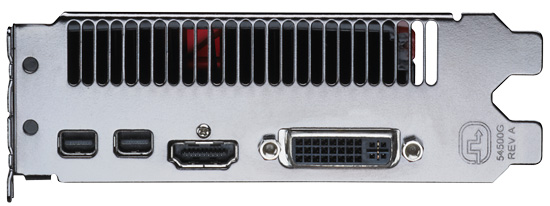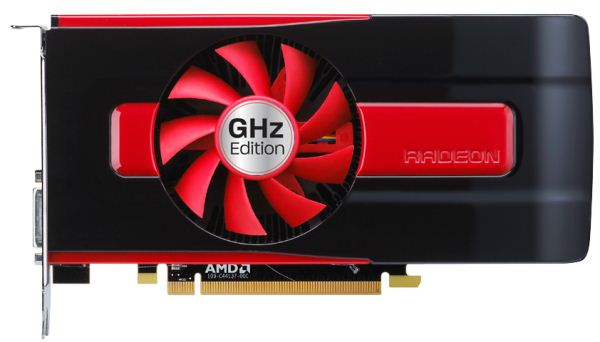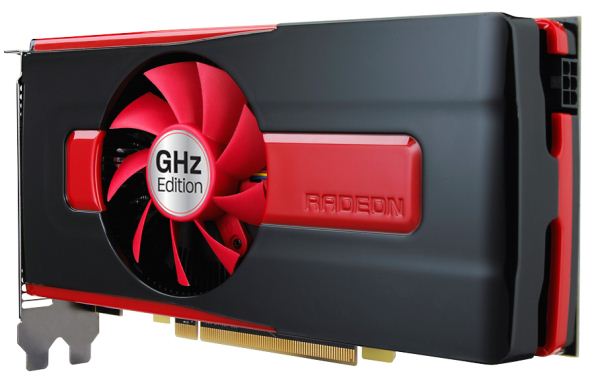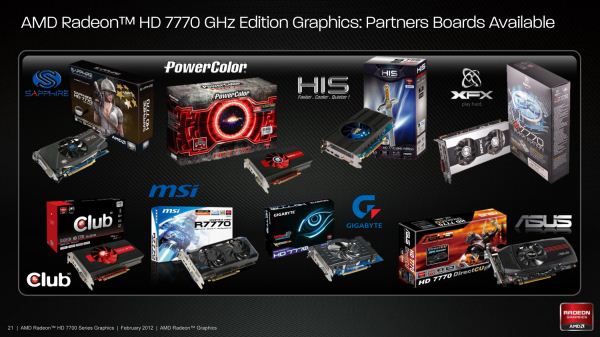AMD Radeon HD 7750 & Radeon HD 7770 GHz Edition Review: Evading The Price/Performance Curve
by Ryan Smith & Ganesh T S on February 15, 2012 12:01 AM EST- Posted in
- GPUs
- AMD
- HTPC
- GCN
- Radeon HD 7000
Meet the Radeon HD 7770 GHz Edition
The second card launching today is the Radeon HD 7770 GHz Edition. Compared to the 7750 it’s based on a fully enabled Cape Verde GPU and features a higher core clock of 1GHz, versus 800MHz on the 7750.
Starting as always with the cooler, for the reference 7770 AMD has gone with something that is best described as half of a blower. The shroud is completely enclosed on the sides, but due to the position of the fan the card exhausts hot air out of both the front and the rear of the card, which is something that’s common for dual-GPU cards such as the 6990 but atypical for a midrange video card. Heat transfer is provided by a basic black aluminum heatsink, while the fan is embedded in the middle of the heatsink.
As for the card itself, it’s effectively an extended version of the 7750. Like the 7750 the card is equipped with 4 256MB 5GHz Hynix GDDR5 RAM chips, along with some additional VRM circuitry to handle the higher 100W power limit for this board. External power is provided by a single 6pin PCIe power socket, while at the top of the card there is a single CrossFire connector. This is actually down from 2 connectors on the 5700 series, which comes as no great surprise as virtually no one ever used tri-CF with the 5700 series in the first place. Overall the card is 8.25” long with no notable shroud overhang, making it the same length as the 5770’s PCB.
Meanwhile for display connectivity AMD is using the same configuration as we’ve seen on the 7900 series: 1 DL-DVI port, 1 HDMI port, and 2 miniDP ports. Unlike the 7900 series AMD’s not requiring their partners to include any adaptors, so buyers with 2 DVI monitors will almost always be on their own. The presence of 2 miniDP ports means that the 7770 has quite a bit of flexibility in driving various displays, however as with the 7900 series if you want to drive more than 4 displays you will need a MST hub, the release of which is still some time off.

As for partner cards, as with the 7750 all of AMD’s partners are doing their own thing. No one will be using AMD’s reference cooler, though PowerColor in particular will be using a cooler similar to it. Everyone else will be using their own double-wide coolers, most of which will be open air as we typically see in this market segment. Like the 7900 series AMD is relying on the 7770 having some degree of overclockability, so there will be a number of factory overclocked cards taking advantage of this.
Finally, I wanted to quickly touch on the naming of the 7770. The official name of the 7770 is the Radeon HD 7770 GHz Edition; with the last bit being AMD’s latest marketing push. Starting with the 7770, AMD is going to be branding every card with a reference clock at or above 1GHz as a “GHz Edition” card to capitalize on the fact that they’ve hit 1GHz. Thus in spite of what the name implies there won’t be a 7770 non-GHz Edition card, as it’s a tagline rather than a true suffix necessary to differentiate cards.
With that said, while hitting 1GHz on a GPU is a notable accomplishment for AMD and should not be ignored, it’s not going to be particularly important in the grand scheme of things. The embarrassingly parallel nature of rendering means that GPU performance isn’t nearly as tied to clockspeeds as CPU performance is, as you can always lay down more functional units to improve performance. Clockspeeds do need to go up over time due to the limited parallelization of the command processor, but otherwise GPU performance has never been heavily dependent on clockspeeds.



















155 Comments
View All Comments
rdh - Wednesday, February 15, 2012 - link
Bingo. But your numbers look at if you were to want to buy today. You might have bought the 5750 or 5770 at a significantly lower cost during a sale in the past 2.5 years. So individual price comparisons may be different than today's prices.IN ADDITION: the 7770 and 7750 require about 3% less power and produce frame rates about 10% higher than their 57xx counterparts. This is after the 57xx have been out for nearly TWO AND HALF YEARS. I purchased both (the 5750 for one system at $65 and the 5770 for another at $99) about 6 months after introduction. Two years later, there is no compelling reason for me to upgrade. That means AMD is only going to be selling these to new desktop purchasers.... a quickly shrinking market. This cannot be good for AMD.
CeriseCogburn - Saturday, March 10, 2012 - link
Since fps is your only metric, itself being a murky and disturbed error filled easily biased mess based upon game set, driver cheating, resolutions, and in game settings chosen, the entire price/perf chart is EPIC FAIL.When your drivers crash, when your game doesn't work, when new games don't work for weeks and months, when dual card drivers are absent, when features like PhysX are no can do - NONE OF IT IS ACCOUNTED FOR....
---
Obviously all amd has to do is follow the simpleton idiot fps/per dollar formula for all the stuck cursor gsod fanboys to bloviate and screech they saved 20 cents... then the amd forum masters casn continue to lock them out, lock user problem threads, and smart off that "it's works for them on their eyefinity setup theya re starig at right now"...
---
When a crazed, worship filled, religious zealoutry claims the heavens have opened on the cheap and the devil competition has lost all, beware...
Oh.. wait... sorry talking to the wrong person...
Roland00Address - Wednesday, February 15, 2012 - link
I am curious how high these cards will go before they hit the powertune limits.Ryan Smith - Wednesday, February 15, 2012 - link
I'm still writing up an addendum, but here's what I have for the 7770.Ref 7770: 1125MHz core, 4.8GHz memory
XFX 7770: No meaningful overclock on top of XFX's factory overclock. Crashed at 1160MHz core
As for performance, basically look at the XFX card.
Roland00Address - Wednesday, February 15, 2012 - link
Personally I find that the more interesting cardRyan Smith - Wednesday, February 15, 2012 - link
We didn't do any overclocking tests on the 7750. It was necessary to quickly test it in order to be able to ship it to Ganesh for HTPC testing.DarkSynergyt - Wednesday, February 15, 2012 - link
Might be a stupid question but can the 7750 output audio over HDMI? I'm in the process of building an HTPC and this is the final piece to the build.evilspoons - Wednesday, February 15, 2012 - link
My 6570 can and I'm pretty sure they said in the review that it has all the same features as previous generations for video features.ganeshts - Wednesday, February 15, 2012 - link
Yes, it does. With full bitstreaming options too (even WMA Pro). 7.1 channel LPCM support is also there. No worries. (Of course, hot plugging [ say, moving from a direct monitor connection to an AV receiver input ] causes the audio output to act crazy, but that is the case with every card. Reboot fixes the issue)evilspoons - Wednesday, February 15, 2012 - link
This really drives home how obsolete my GTX 285 is. The 7770 has about equivalent performance and uses *130 watts* less.I need a new video card, but I want to see what Nvidia has for us next - I'm not a fanboy (in spite of all my gaming cards since the 3dfx Voodoo 3 being Nvidia), I'm just genuinely hoping for either some competition to drive prices down or something better to blow us away. Come on guys, get a move on already!